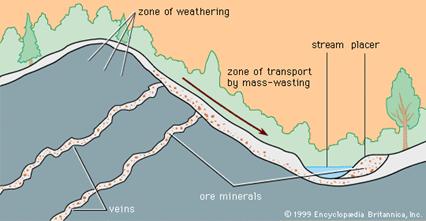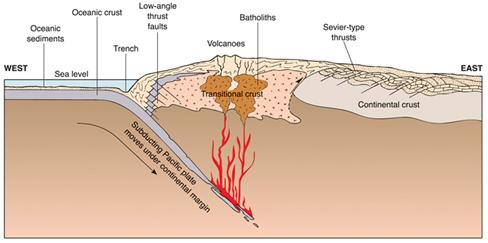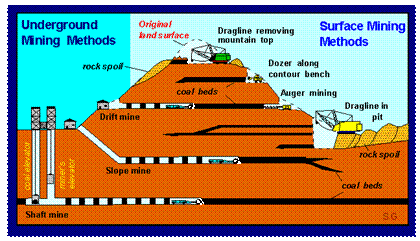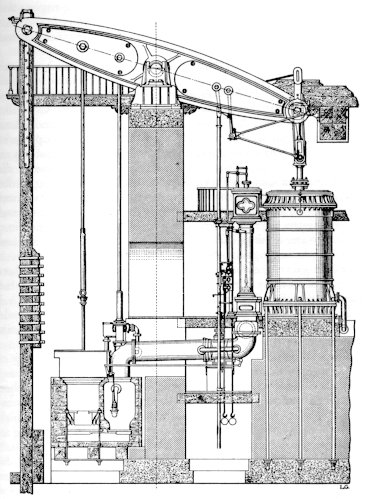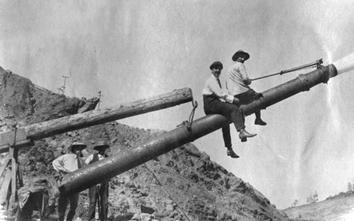Geology and Natural Heritage of the Long Valley Caldera
Gold Formation, Extraction, and Refining in the Sierra Nevada Mountain Region
Isabella Niloofar Cross-Najafi
Abstract
Gold formation processes include hydrothermal processes in which water becomes heated underground when it is close to a geothermal site, dissolving many ores which have been trapped in the surrounding rock and then through cooling the ore precipitates into a solid and purified metal. Gold was formed in the Sierra Nevada inside the Smartville block while it was still underwater and it was later brought to the surface through tectonic movement. This formation process exposed many sites which were ideal for gold mining. The miners learned that placer deposits could be excavated in many ways. They also learned that hard-rock deposits were the original sources for the eroded ore that was washed into the placer deposits. Miners learned that the presence of granite and quartz indicated an ideal location for gold formation. Placer deposits were mined in many ways using panning, drift, and hydraulic mining methods. Panning was a way to mine placer deposits and the only tool used was a gold pan. Drift mining was used to extract gold from deep within the earth. Hydraulic mining is used to excavate ore-rich gravel from deep within the earth by blasting an exposed ore-rich bank of gravel with highly pressurized water. There are many different methods of gold mining specifically used on the gold deposits of the Sierra Region. These include heap leaching, open-pit mining, and extraction through the Cornish pump. Heap leaching was one of the first methods used in mining in which the ore was crushed and then drenched in cyanide to dissolve the gold out of the ore in order to refine it. Gold is extracted from the ore in mills where the ore is crushed and then dissolved in cyanide. The cyanide is exposed to an electric current and the gold reforms into a solid which is then remelted into gold bars. These gold bars are the final stage of the gold and are exported all over the world. Many environmentalists are concerned about the mercury content of the soil and drinking water in and around some of the old mining towns.
Introduction
The relationship between man and gold goes back 6,000 years. Gold artifacts survive from ancient civilizations and cultures such as the Egyptians and the Mesopotamians (Winter, 1993). Gold is valued so highly because of its many uses and its physical beauty. The chemical symbol for gold is Au. It has an atomic number of 79 and an atomic weight of 197.2 (Winter, 1993). It has a bright yellow color, is very opaque and has a metallic luster. In nature gold can occur in four habitats: crystalline masses, flat plates, nuggets, and in grains, some of which are so fine they are invisible to the naked eye (Bonewitz, 2008). Gold can also be found in a compound of several elements such as sulphides and tellurides and it is known as the most ductile and malleable metal in the world. It can be stretched and manipulated into many different forms, which is helpful when metalworking. However, gold is also very soft and usually has to be alloyed with another metal for it to retain its shape (Bonewitz, 2008). Silver, platinum, nickel, and zinc can be alloyed with gold to form white gold, while gold alloys with copper to form pink gold, and with iron to form a bluish gold (Bonewitz, 2008). This precious metal can be used in jewelry, ornamentation, and as currency. Gold also has industrial uses in electronics due to its high electrical conductivity and its non-oxidizing nature (Bonewitz, 2008).
The demand for gold has always been high due to its scarcity. The first discovery of gold in California occurred when miners came across significant ore deposits near Sacramento in 1848 (Whaples, 2010). This discovery triggered a massive influx of people from all over the world who moved to the west coast of the United States in hopes of making a fortune. Gold has been an important part of the economy of the Sierra Nevada region ever since. In this paper I will discuss how gold in this region is identified, how it originated, how it is extracted, and what processes are used to refine it.
GOLD FORMATION IN THE SIERRA NEVADA
Gold formation in the Sierra Nevada began as far back as the late Jurassic period. 160 million years ago, sediment was deposited in a wedge-shaped basin along the western edge of the North American tectonic plate (Hill, 2006). This basin is named the Smartville complex, or Smartville block, after a small mining town that was later built there (Hill, 2006). Gold is constantly formed within the magma beneath the earth’s crust. The gold found in the Smartville complex was formed by a process known as a hydrothermal process, in which gold ore is brought to the surface from deep within the earth through lava flows along mid-oceanic faults (Hill, 2006). As the lava cools on the sea floor, cracks form on the surface allowing seawater to penetrate the lava. The chlorine from the salt in the seawater becomes heated, facilitating a chemical reaction which helps dissolve the metals within the rock. As the ore-rich hydrothermal solution rises through cracks in the oceanic crust, it cools, resulting in the re-solidifying of dissolved metals such as gold (Hill, 2006). The large concentrations of gold and other ores in the oceanic crust are due to these hydrothermal processes. This is how gold initially became concentrated in the Smartville complex.
The Smartville Block
The Smartville block is the source for most of the gold mines in and near the Sierra Nevada region. This gold-rich block, which lay between the Pacific and North American continental plates, now lies below both the Sierra Nevada and the Central Valley and is about 25 miles wide (Hill, 2006). The block began its voyage inland when it rode over two ocean trenches off the coast of California. It is unknown whether the block began to subduct into the trenches and then sheared off, or just rode over them completely, but in either case the Smartville block continued to move inland and eventually collided with California and helped to form the Sierra Nevada mountain range. With the Smartville complex came the large hydrothermal gold deposits that lay within its crust (Hill, 2006).
Formation of Hydrothermal Gold Deposits within the Smartville Block
Twenty million years later, multiple faults formed throughout the slowly growing mountain range (Hill, 2006). Ground water near the tectonic activity became heated by magma from an igneous intrusion close to the earth’s surface (Hamburger, Hereford, & Simmons, 2010). The high pressure combined with high mineral concentration in the water of minerals such as chlorine, fluorine, and carbon dioxide enabled the water to absorb and dissolve metals, such as gold, in the surrounding rock (Hamburger, Hereford, & Simmons, 2010). This new ore-rich solution, or hydrothermal solution, continued to flow closer to the earth’s surface by entering other thin fractures, or joints, in the overlying rock (Hamburger, Hereford, & Simmons, 2010). As the water cooled the ore precipitated into a solid form again and formed veins of ore within the thin fractures, which are also known as hydrothermal deposits (Hamburger, Hereford, & Simmons, 2010). Ore minerals are generally found precipitated with quartz, calcite, and other minerals (Hamburger, Hereford, & Simmons, 2010). It is these other precipitates that have helped people locate potential source rocks for gold during and after the gold rush of the late 1840‘s.
CONDITIONS OF GOLD DEPOSIT FORMATION
Placer Deposits
In many cases, the discovery of an ore-rich source rock happened entirely by chance. Many people found gold known as placer deposits in rivers, where the ore was washed out from hard rock deposits due to wind and water erosion (See Fig. 1.) (“Placer deposit”, 2010). Stream placers, also known as alluvial placers, are the best-known of all placer deposits (“Placer deposit”, 2010). A stream placer is created when a powerful body of water transports gold, along with other precious minerals and stones, far from its source within the hard rock deposit. The ore is sorted from the silt and sand by the velocity of the water. Heavier minerals are dropped before the lighter ones as the velocity of the water decreases (“Placer deposit”, 2010). Placer deposits were most likely the earliest mined deposits due to the accessibility of the gold (“Placer deposit”, 2010). Alluvial placers are slightly different. The deposits are already located on a hilltop and remain stationary as wind and water erode away finer sediment (“Placer deposit”, 2010). The exposed ore can then be panned by anyone who happens to come across the deposit. Beach placers are placers where the ocean tides sort out sediment from the ocean floor in order of weight and size (“Placer deposit”, 2010). The fine sediment is washed ashore leaving larger ore-rich deposits farther offshore in deeper waters (“Placer deposit”, 2010). Eolian placers form in more arid and desert regions with little rainfall. These deposits are not sorted by water erosion but by wind erosion (“Placer deposit”, 2010). The fine particles are blown away and leave the larger pieces of ore exposed. Eventually these placer deposits in the Sierra Nevada region became depleted of ore after miners and prospectors gleaned the precious metal ores and precious stones from them. The miners had to find more to continue to support themselves.
Hard-Rock Deposits
Gradually miners came to find that much of the gold that they were panning came from an initial source in the earth called a hard-rock deposit. The deposits in the Sierra Nevada were mostly gold-quartz veins formed through hydrothermal deposition (Alpers, Hunerlach, May, & Hotheim, 2005). Many prospectors claimed that a person could tell the difference between potentially gold rich quartz (deemed “live” quartz) and “dead” quartz just by looking at a sample (Hill, 2006). They claimed that the live quartz appeared less lustrous than other non-ore-bearing quartz and also seemed more opaque (Hill, 2006). When they traced the quartz back to its source they discovered many different kinds of hard rock deposits.
Hard-Rock Deposit Locations
Most of the gold deposits found and mined were gold-quartz veins, many of which were found near the fault lines which striped the basin and range province from North to South (Ralph, 2003). The basin and range province is a series of mountains and valleys caused by the stretching of the North American plate from both the East to West coasts (Hamburger, Hereford, & Simmons, 2010). The faults generated by this tectonic movement run from North to South and have aided in the formation of the Sierra Nevada mountain range which runs parallel to these faults (Ralph, 2003). The strike of these faults ranges from 15-30 feet, and many scientists theorize that the tectonic movement along the faults generated enough heat to catalyze the formation of gold-quartz veins by providing ideal conditions for crystal growth (Ralph, 2003). The Sierra Nevada batholith is a large body of granitic rock that underlies the Sierra Mountains (Hill, 2006). These veins were formed within the metasedimentary rock lying above the granitic Sierra Nevada batholith (Hamburger, Hereford, & Simmons, 2010). (See Fig. 2.) Miners have probably located many ore deposits in the Sierra Nevada region just by looking out for exposed granitic outcrops and quartz veins. Once the miners found these ore deposits they needed ways to extract the ore from the earth, spurring the creation and development of many gold mining techniques.
GOLD MINING METHODS
Placer deposits were mined in many ways using panning, drift, and hydraulic mining methods (Alpers, Hunerlach, May, & Hotheim, 2005). Panning, one of the earlier forms of mining, has been used all over the world. It involves the use of one tool: the gold pan (Griffith, 1960). Gold pans are usually wide and shallow with a metal rim around the top to avoid sediment loss (Griffith, 1960). The first miners found ore-rich sediment from placer deposits at the bottom of a river and they would pile it inside of the gold pan (Griffith, 1960). The sediment would mix with the water forming what is now called “sluice” which the miners would then sort by moving the pan around in a horizontally circular motion (Griffith, 1960). This would cause the denser pieces of gold ore to sink to the bottom of the pan, leaving the unwanted light sediment to float to the top and get washed away (Griffith, 1960).
Drift Mining
Underground mining methods, called drift mining, are used to extract gold ore from deep within the earth (Ralph, 2003). Drift mining is used to mine alluvial deposits by mining underground (Griffith, 1960). The ore is either removed manually with large picks or it is blasted out of the earth with dynamite (Griffith, 1960). (See Fig. 3.) A tunnel is then carved and the extracted sediment is carried to a collection bin before it is transferred to a sluice box (Griffith, 1960). A sluice box is a large box in which the mined sediment and dirt were mixed with water in order to catch the ore at the bottom while eliminating excess sediment (Griffith, 1960). Riffles are wooden rods, usually about 1” tall, which are secured horizontally across the bottom of the sluice box (Griffith, 1960). These riffles are placed at the bottom of the sluice boxes so that they can act as miniature speed bumps. They hinder excess sediment and ore loss and aid in the sorting process (Griffith, 1960).
Heap Leaching
Heap leaching was one of the first methods used in mining in which the ore was crushed and then drenched in an acid called cyanide which then dissolved the precious metals out of the ore (Hill, 2006) A much more profitable mining technique developed shortly after called open pit mining (Hill, 2006). In this method, miners dig large holes into the hillside with machinery and carry out the ore that they find (Hill, 2006). The disadvantage to this method was that the inhabitants of the mining towns were unhappy about the heavy noise pollution created by the machinery (Hill, 2006). Later on in the history of Sierra Nevada mining came the Cornishmen from England (Hill, 2006). With them they brought new mining technology now christened the “Cornish pump.” The Cornish pump consists of several pumps spaced about 200 feet apart which would each bring ground water up to a cistern near the next one (Hill, 2006). Gradually the Cornish pumps would pull all of the sediment and ground water to a drainage tunnel to be sorted through and refined
(Hill, 2006). (See Fig. 4.)
Hydraulic Mining
Hydraulic mining is when ore-enriched gravel is excavated an exposed ore-rich bank of gravel with highly pressurized water (Alpers, Hunerlach, May, & Hotheim, 2005). Hydraulic mining was one of the most productive kinds of mining and the process was widely used until the late 1880’s (Alpers, Hunerlach, May, & Hotheim, 2005). The machines that miners used to blast the gravel were named Giants, or Monitors (Griffith, 1960). (See Fig. 5.) These machines forced the water into a straight line and had the power to create a deep cave in the side of a landmass very quickly (Griffith, 1960). The situation presented a hazard to both miners and the expensive machinery because occasionally the hole would be made at the base of the landmass and shortly thereafter it would collapse (Alpers, Hunerlach, May, & Hotheim, 2005). After the sediment was removed, the water was redirected to what is called a sluice line where the ore was recovered and washed. This mix of water and sediment, also called a slurry, was passed through enormous amounts of mercury placed in tubs
called “riffles” and “troughs” (Alpers, Hunerlach, May, & Hotheim, 2005). The process of submerging sluice into mercury worked well because mercury’s density caused most of the extraneous sediments to just float above the mercury while the denser gold ore sank to the bottom of the solution (Alpers, Hunerlach, May, & Hotheim, 2005). One problem with this method was that the large amounts of water gushing through the sluice of mercury hindered the settling of many smaller bits of gold and mercury. As a result the small precious pieces of gold were lost to the waste drainage (Alpers, Hunerlach, May, & Hotheim, 2005). This problem was solved, however, with the introduction of the ‘undercurrent’ (Alpers, Hunerlach, May, & Hotheim, 2005). The undercurrent was a different waterway that carried smaller particles of sediment to a copper plate painted with mercury while other tunnels were made to facilitate waste drainage from the bottom of the hydraulic mine pits (Alpers, Hunerlach, May, & Hotheim, 2005). The mercury in the copper plate helped catch the tiny bits of gold that lay amongst the finer grains (Alpers, Hunerlach, May, & Hotheim, 2005). Sorting out gold ore with mercury worked well for miners until people became aware of the negative effects of mercury on the human body. The use of mercury for mining would later give rise to many environmental and health issues which still plague mining areas today (Alpers, Hunerlach, May, & Hotheim, 2005).
GOLD EXTRACTING PROCESSES
Following the mining process is the process of extracting the gold from the rock. The ore-rich rock is transported to a mill where it will be extracted (Harris, 2009). Machines called crushers smash the ore to pieces that are the size of gravel. The ore is further smashed into a powder using a machine that looks like a large spinning drum with steel balls inside. The balls spin with the drum and crush the ore through collision (Harris, 2009). This powder is called a slurry which is thickened with water to create a pulp (Harris, 2009). The pulp then enters a leaching tank filled with cyanide which extracts the gold by dissolving it. The chemical extraction process is called a Carbon-in-Pulp extraction. When cyanide reacts with oxygen it can dissolve metal. The miners used cyanide to dissolve and retain the gold while eliminating the rest of the sediment and waste material (Harris, 2009). Next, the miners would add small carbon particles (Harris, 2009). These would cause the gold to stick to them and re-precipitate into gold-carbon clumps which were then sifted out of the pulp using screens (Harris, 2009). The clumps were put into what is called a caustic solution which caused the gold to separate from the carbon particles (Harris, 2009). The carbon would be filtered out and saved for future use while the gold continued on to the next process called electrowinning (Harris, 2009). Electrowinning is the process where gold is resolidified by pouring a gold-rich solution into what is called a “cell” with positive and negative charged parts called terminals (Harris, 2009). The electric current causes the negative terminals to collect gold, once again, in solid form (Harris, 2009). Smelting is the final step in the purifying process. The miners would take the whole terminal and melt it at around 2,100 degrees C, and put flux on the outside so that the metal of the actual terminal and the metal of the gold would separate from each other (Harris, 2009). Then the gold is poured into molds which create gold bars and these bars become the final product (Harris, 2009).
NEGATIVE EFFECTS OF MINING PROCEDURES
Mercury Contamination
Many mining areas have seen the environmental destruction that has resulted from mining activities in the area. The main environmental concern many have is about the mercury content of the soil and drinking water in and around some of the old mining towns (Alpers, Hunerlach, May, & Hotheim, 2005). The gold rush mines used large amounts of mercury to mine, and up to 30% of their mercury was lost in the Sierra Nevada region (Alpers, Hunerlach, May, & Hotheim, 2005). The sum total of mercury lost in California is estimated at about 10,000,000 pounds (Alpers, Hunerlach, May, & Hotheim, 2005). Around 80-90% of this mercury was lost in the Sierra Nevada (Alpers, Hunerlach, May, & Hotheim, 2005). These high levels of mercury loss resulted in heavy pollution of the mines and the surrounding residential areas as well (Alpers, Hunerlach, May, & Hotheim, 2005). The hydraulic mining of gold-bearing placer gravels caused downstream flooding and the destruction of many citizens’ homes because of the leftover mining detritus (Alpers, Hunerlach, May, & Hotheim, 2005). The authorities managed to stop the hydraulic mining debris deposition in rivers with the Sawyer Decision of 1884 (Alpers, Hunerlach, May, & Hotheim, 2005).CONCLUSION
Gold mining plays a crucial part in the history of the Sierra Nevada both economically and geologically. Although the gold rush is long over, gold still plays an important role because it is in high demand. Gold is needed for jewelry, decorative objects, and electronics and therefore there are always people searching for gold to supply those needs. The future of mining depends greatly on the past. Technology and new tools have been developed since the gold rush, enabling new gold-ore deposits to be found that were left unnoticed the first time around. Inventions such as the metal detector and heavy machinery such as bulldozers and dump trucks have greatly improved mining efficiency (Ralph, 2003). Small pockets of gold still remain in hillsides where, underneath dirt and clay, there may lie many residual deposits created in the tiny veins that were too small to notice without a metal detector (Ralph, 2003). The process of mining has changed drastically over time and will continue to change to fit the available supply of gold.
Works Cited
Alpers, C.N., Hunerlach, M.P., May, J.T., & Hotheim, R.L. (2005). Mercury contamination from historical gold mining in California. USGS Publications, 2005(3014), Retrieved from http://pubs.usgs.gov/fs/2005/3014/
Bonewitz, R.L. (2008). Gold. (2008). Rock and gem: the definitive guide to rocks, minerals, gems, and fossils. New York, United States: DK Publishing, Inc.
Griffith, S.V. (1960). Alluvial prospecting and mining. 2nd ed. Great Britain: Cox and Wyman, Ltd.
Hamburger, M., Hereford, A., & Simmons, W. (Ed.). (2010). Volcanoes of the Eastern Sierra Nevada: Geology and Natural Heritage of the Long Valley Caldera. Bloomington, IN: Indiana University Department of Geological Sciences.
Harris, W. (2009). How Gold Works. Howstuffworks.com. Retrieved (2010, June 8) from http://science.howstuffworks.com/gold4.htm#
Hill, M. (2006). Geology of the Sierra Nevada. Berkeley and Los Angeles, CA: University of California Press.
Levin, H.L. (2006). The Earth through time [Eighth ed.]. Retrieved from http://higheredbcs.wiley.com/legacy/college/levin/0471697435/chap_tut/chaps/chapter15-04.html
Lienhard, J.H. (1997). No. 482 cornwall west. Retrieved from http://www.uh.edu/engines/epi482.htm
Men astride a giant monitor. (2009). Retrieved from http://www.learncalifornia.org/doc.asp?id=819Methods of mining. (2006, February 26). Retrieved from http://www.uky.edu/KGS/coal/coal_mining.htm
Placer deposit. (2010). In Encyclopædia Britannica. Retrieved June 04, 2010, from Encyclopædia Britannica Online: http://www.britannica.com/EBchecked/topic/462598/placer-deposit
Ralph, C. (2003). The Geology of coarse gold formation. Retrieved from http://www.nuggetshooter.com/articles/CRGeologyofcoarsegoldformation.html\
Whaples, R. (2010). California Gold Rush. The Eh.net encyclopedia. Retrieved (2010, June 3) from http://eh.net/encyclopedia/article/whaples.goldrush
Winter, M. (1993). Gold: the essentials. Retrieved from http://www.webelements.com/gold/
